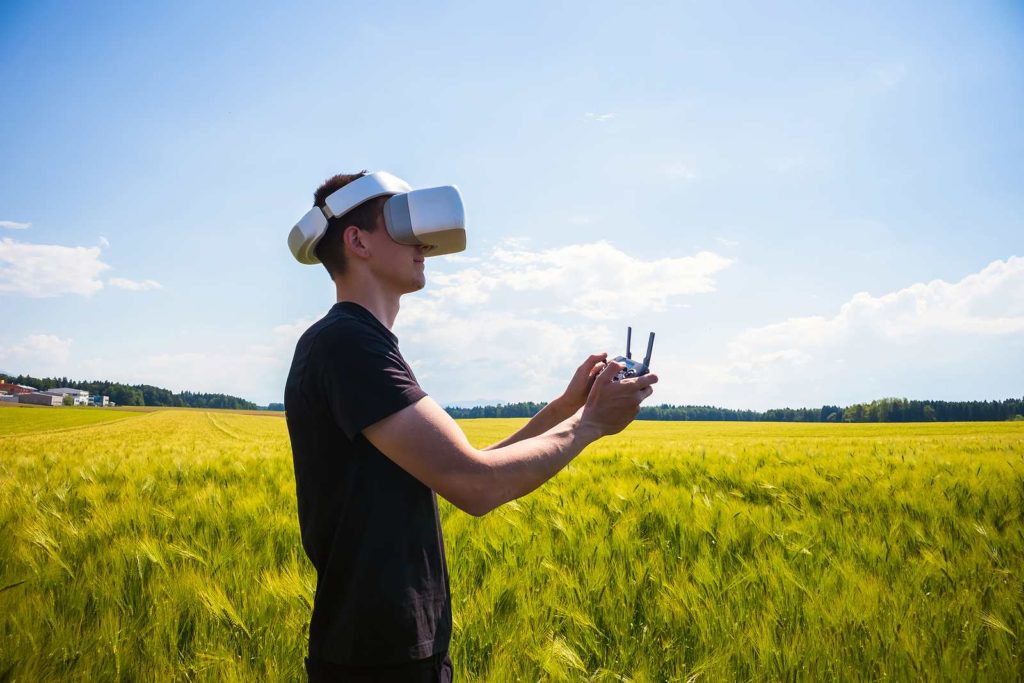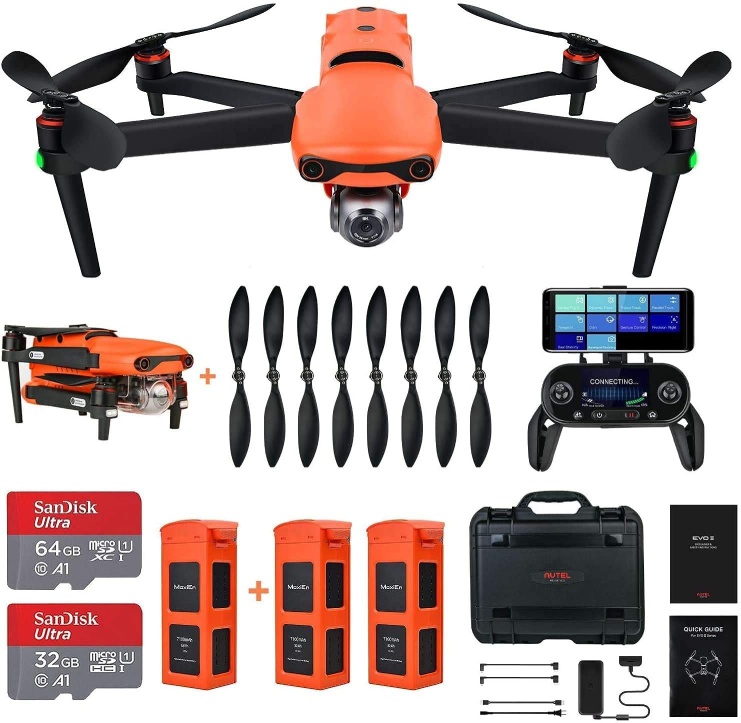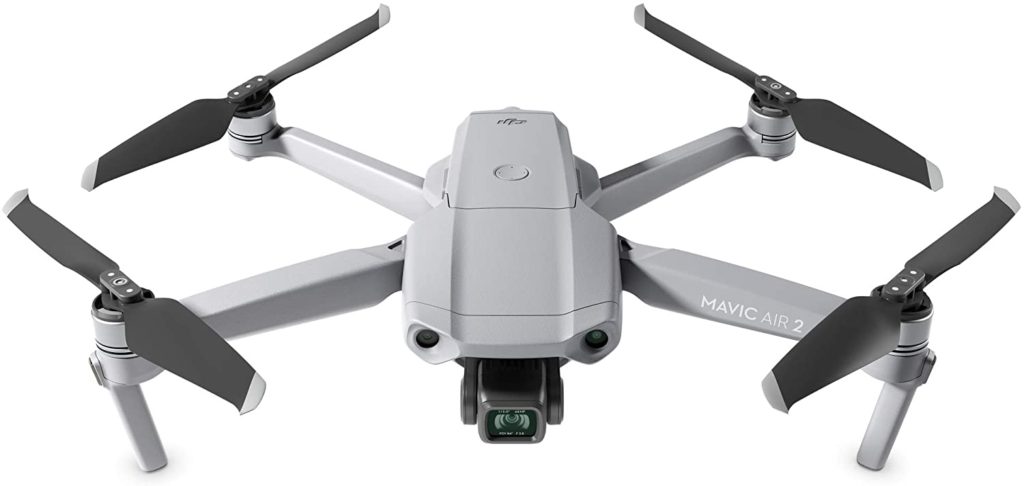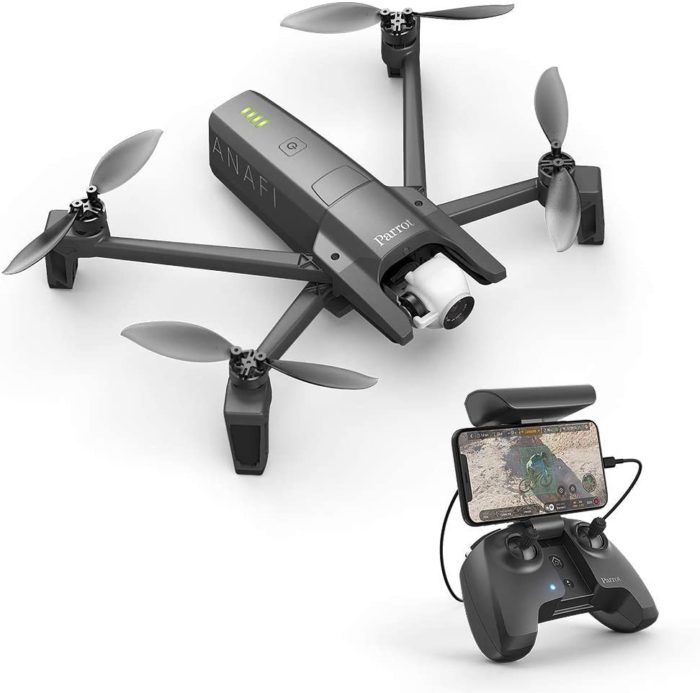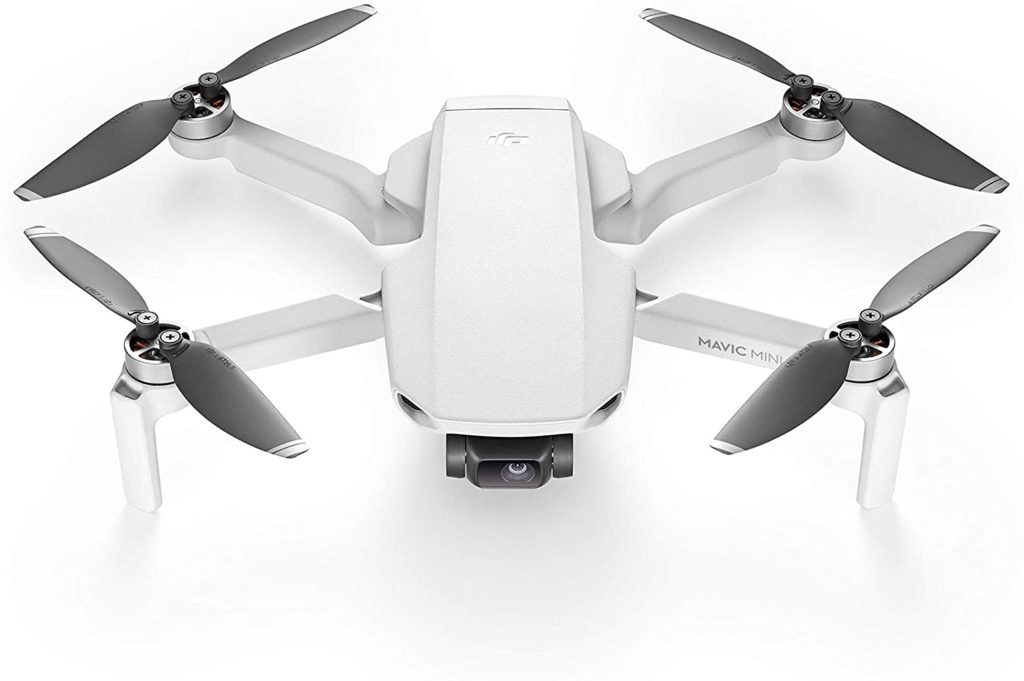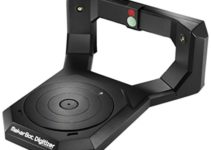IN A HURRY? CHECK OUT Autel Robotics Evo II Pro VR Drone TOP PROS:
One of the areas generating the biggest interest in the technology market today is the combination of VR with drones.
Owning unmanned aerial vehicles (UAVs) commonly called drones has been known to excite a lot of people across different age groups. Moreover, the ability to control a drone using a VR headset generates a bigger excitement than just owning a drone.
With a VR drone, you feel more immersed in the flight than just using a remote controller to direct your drone.
In recent years, there has been a lot of development in the virtual reality drone market. Demands for these products are on the increase. The reason for the increase in demand for them is not far-fetched. VR drones provide an experience like no other. Combining VR and UAVs has been a deal-breaker.
Imagine for a moment, you can direct the movement of a drone by merely moving your head while being able to see whatever the drone sees.
This practically means you can be outside your home and be viewing things miles away.
No feeling beats this! Some real estate agents have been making use of VR drones.
If you are interested in buying some properties, all you have to do is to put on a VR headset and make use of a drone to make the necessary inspections of the properties.
Now, without further ado, let’s dig deeper into the matter.
CONTENTS:
- Before you buy: 4 things you have to consider before buying VR drones
- 4 Best VR drones
- Drone safety rules
- Frequently asked questions
- Conclusion
Before you buy: 4 Things you have to consider before buying VR drones
Since the VR drone field is relatively new, it is important to get familiar with it before deciding to buy a virtual reality drone.
These gadgets are quite expensive compared to a regular drone without a VR headset.
There are certain factors you should put into consideration before purchasing a VR drone. The factors to be considered include:
- Safety
- Cost
- FPV goggles
- Legal issues
Safety
As the saying goes, “safety first”. Buying a drone is not child’s play. For you to successfully pilot a drone, you must adhere to some safety measures.
Unless you have some natural piloting skills, during your early few flights, your ability to direct a drone might not be all that good.
Before you attempt to pilot a drone all by yourself, it’s vital to have some sort of tutorial. Mastering safety features would also help in piloting a drone.
A few things you can learn about before piloting a drone include GPS, geo-fencing, and object avoidance technology.
When you understand what piloting a drone involves, you will be better able to control your drone away from mapped structures such as bridges, and other architectural structures.
Amateur pilots should endeavor to purchase drones with flights and landing tutorials. They should also go for drones that won’t allow them to gain access to advanced flying techniques until they’ve mastered the basics.
Cost
Cost is another important factor that should be considered before delving into the world of VR drones. The cost of unmanned aerial vehicles (UAVs) varies widely.
You may even have difficulty not knowing which drone to go for. On average, drones range in price from $450 to $1699. These prices are not fixed. Market forces dictate the prevailing cost of VR drones.
When buying a VR drone, you should understand the main reason why you are buying one. The reason being that VR drones don’t come cheap.
Big virtual reality drones manufacturers like DJI, Walkera, and PowerVision sell their drones at a pretty high cost. These drones are expensive because of the modern innovative technology they are equipped with.
These drones are equipped with VR goggles which helps users to view images with minimal delays.
The best drone to acquire nowadays is the FPV drone, but if you are a newbie to VR drone, the VR drone aviation is always a good beginning point.
FPV Goggles
When you’re out looking to buy a VR drone, your goal should be buying a VR drone packaged with FPV goggles.
You might be wondering what FPV stands for. FPV stands for the First-person view.
As a VR drone enthusiast, for you to get a VR drone that suits your needs, our team recommends going for VR drones with longer battery life. FPV goggles that can easily be set up without much stress and those with short pairing time should be high on your priority list.
One thing some VR enthusiasts fail to pay attention to is the axis points on the gimbal of the VR drone model. The more the number of axes on its gimbal, the smoother the video footage. If you are purposely buying a drone for FPV VR drone racing, pairing your VR headset with FPV goggles should not be complicated.
Legal issues
Drones are heavily regulated in the most advanced countries of the world. To successfully own and pilot a drone, you should know the laws governing drone use in your home country. For example, some of the laws governing drone use in the United States include:
- You must be able to read, speak, write, and understand English (exceptions may be made if the person is unable to meet one of these requirements for a medical reason, such as hearing impairment).
- You must be in a physical and mental condition to safely operate a small UAS.
- You must be at least 16 years old.
- You must pass an Aeronautical Knowledge Test—also known as the Part 107 test—at an FAA-approved knowledge testing center.
- You must undergo Transportation Safety Administration (TSA) security screening.
Understanding and following the rules that apply to drone use in your home country is quite important in preventing clashes with the authorities.
Quick Summary
| IMAGE | PRODUCT | DETAILS | |
|---|---|---|---|
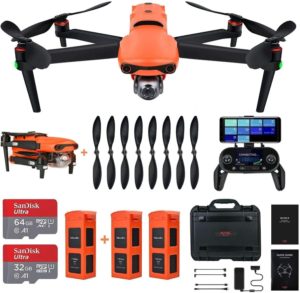 |
Our #1 Choice
Autel Robotics Evo II Pro VR Drone |
|
Check on Amazon |
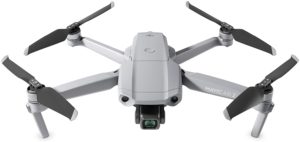 |
DJI Mavic Air 2 – VR Drone Quadcopter UAV |
|
Check on Amazon |
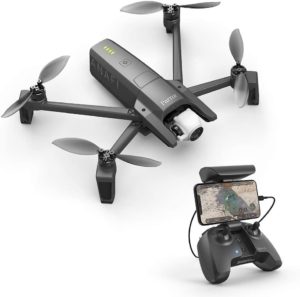 |
Parrot Anafi VR Drone |
|
Check on Amazon |
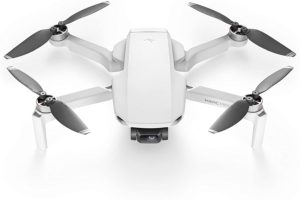 |
DJI Mavic Mini VR Drone |
|
Check on Amazon |
4 Best VR Drones
1. Autel Robotics Evo II Pro VR Drone
Unique features:
- 360° obstacle avoidance
- 40mins flight time
- 59 miles transmission range
Best VR drone for:
- Photography
Overview
Most of the available consumer drones can be synced with a smartphone app. So all you need to do is to sync it with your smartphone to see through the camera and snap quality photos. But this is not the case with Autel robotics Evo ll Pro. It employs the use of a controller that allows users to fly, frame photos, and record videos without the use of an external device. This VR drone is effective all around. This drone provides the flight experience you might have been craving all this while.
This VR drone doesn’t come cheap at $1,769, but it provides the best value at that amount. One special thing about this drone is that users are paying more for the ability to control this drone without their smartphones. One downside of the product is that users later discover that many camera features of this product still require a smartphone app.
One notable feature of this product is its unique color. The orange color of this VR drone makes it highly visible.
The orange color contrasts with the blue color of the skies and the green vegetation of the land.
These contrasting colors make this VR drone stand out. The battery of this drone is rated to last for about 35 minutes of flight. If you decide to switch to the high-speed flight mode, the battery drains quickly. When this drone is in its standard flight mode, the speed peaks at 22mph and it has a 360° object avoidance ability.
If you’re flying this VR drone in an area highly populated by trees, you don’t have to worry about this.
This VR drone has been designed to avoid any form of obstruction. Even if you fly the drone very low, it won’t still be an issue. It is recommended for users to switch over to Ludicrous mode when flying at top speed. Switching to this particular model gives captured images more sense of motion.
After we reviewed this VR drone, we noticed that this drone allows users to set restrictions on how distant it can fly. But the not-so-good thing is that this VR drone has no geofencing capabilities. As a pilot of this drone, you must know whether you can take off at your current location. To know this, you may go through the FAA’s B4UFLY app for guidance.
One big advantage of the DJI VR drone on our list is that it enforces the no-fly and restricted flight zone by default. Certified drone pilots must unlock some processes before they can take off. If you are certified already, you can easily fly the EVO II as well.
One major downside of this VR drone is the small storage space it is built with. It has a mere 8GB of storage. Although it has a micro USB port to connect with a PC to offload files. In all honesty, 8GB is sort of too low for a drone producing 6K footage. But one good thing is that users of this can get an external micro SD card to input. You can get that for $20 or less.
One other thing we noticed is that the drone’s remote controller makes so much noise. The cooling fan is very loud! Although the cooling fan doesn’t run all the time, once the remote controller is powered on, the loud noise kicks in. If you are on a tight budget, you might consider the DJI Mavic Air 2, the second VR drone on our list.
Pro tips
With this VR drone, you can customize video profiles. The default videos captured by this VR drone are ugly and it has some sort of oversharpened appearance. This is most especially notable in aerials with grass and trees. Doing some photo editing would correct the over-sharpened images. In addition, the manufacturers of this drone provide an official LUT for image editing.
Pros
- Big battery for 30-plus-minute flights
- Obstacle sensors and automated flight paths
- Raw and JPEG image support
Cons
- Default video profile is oversharpened
- Many functions still require a smartphone app
- 10-bit Log video not available at 6K
Bottom line
The Autel EVO II Pro is an amazing VR drone with a reliable 6K camera. One outstanding thing about this drone is that you don’t need a smartphone to make it fly. This orange flying drone is suitable for both advanced and amateur drone pilots.
2. DJI Mavic Air 2 – VR Drone Quadcopter UAV
Unique features:
- 48-megapixel camera
- Stable in relatively bad weather
- Over 30 minutes of battery life
Best VR drone for:
- Those on a tight budget
Overview
DJI Mavic Air 2 VR drone provides the best value for money. This VR drone also boasts of high-quality balance between size, picture quality, and other amazing stuff. Photography-wise, this VR drone delivers top-notch photos.
When reviewing this VR drone, what caught our attention is the fact that this drone shoots 48MP stills, 8K Hyperlapse, and 4K video at 120 Mbs. This is remarkable for the price of this product.
Another amazing feature of this VR drone is that it is equipped with AirSense, the main function of this AirSense is to receive automatic dependent surveillance-broadcast (ADS-B) signals from hovering or very close aircraft within the flight range of this VR drone.
In addition, the exact location of any nearby aircraft would appear on the remote control’s screen. One downside we noticed is this product is bigger than its predecessor. But on a positive note, it is easier to use than the former.
This VR drone features three different photography and video modes which are Hyperlight, HDR, and scene recognition. All these three different modes make the photos captured by this drone superb. The scene recognition feature especially makes photos exceptionally dynamic in tone, clarity, and color.
The DJI Mavic Air 2 has a lot of inbuilt sensors for obstacles or object avoidance. These sensors are like the eyes and ears of the VR drone. In all honesty, this is one of the VR drones that offers the best value for money.
One thing we noticed when reviewing this VR drone is that if the grass is not well-trimmed or freshly cut, you may find it difficult to take off.
As an alternative, you can look for an appropriate flat patch of asphalt to launch. It has a
The manufacturers of this product made a significant improvement in upgrading the flight time of this drone (34 minutes) over its immediate predecessor which is the Mavic Air (21 minutes). When we reviewed it, we found DJI’s rating was close to reality.
If you are flying in a windy situation or any windy situation, your flight time would be 30 minutes or thereabouts.
In terms of safety, this product stands out, this VR drone has many inbuilt sensors to improve safety while flying.
These sensors are made to detect and avoid any kind of obstruction.
But for these sensors to be fully activated, you must turn them on in the app.
This drone has a sort of downward-facing sensor that keeps the drone steady while hovering on a low-level surface without the support of GPS. Both the anterior and rear sensors of this drone are good in detecting obstructions.
This VR drone has good visibility. It is equipped with running lights. And you can turn these lights on if you wish to.
This drone is also equipped with GPS and GLONASS receivers. These receivers are automatically activated for outdoor flight to keep it stable and to track the position of the drone. It also has an ADS-B transponder that gives a warning that there is a manned aircraft near the drone.
What is outstanding about this VR drone is that it will return home with a single click of a button. It also has a find my drone feature which allows users to locate their drone based on the last location of the drone. This feature is also useful for emergency landings.
One of the major downsides of this drone is the inability to get raw images to your tablet or smartphone.
In addition to this, the remote of this VR drone lacks the adjustable antennae that are quite common with other remotes.
You don’t have to be overly bothered by this though, the connection between the drone and the remote is still great. If you prefer a VR drone with an adjustable antenna, you might consider getting an Autel Robotics VR drone on our list.
Pro tips
The controller for this VR drone doesn’t have a display. A user needs to connect his phone if you want to see the view from the camera. A user shouldn’t fly above 400 feet for safety concerns.
Users of this VR are advised not to fly close to the airport. When you fly close to a manned aircraft, a notification pops up on your remote controller.
Pros
- Quick connectivity to FPV goggles
- Compact size
- Competitive price
Cons
- Video profiles limited to standard and flat
- App-based editing limited to 1080p output
- Not easy to get Raw images to your tablet or smartphone
Bottom line
The DJI Mavic Air II offers the best value on our list. The quick connectivity to FPV goggles is amazing. If you are on a tight budget, this product is among the best VR drones you can go for.
If you are also a person who likes compact-size products, you should go for this VR drone. It is highly recommended!
3. Parrot Anafi VR Drone
Unique features:
- 8 optical zoom
- 4K HDR Videos/21 MP Photos
- 180-degree gimbal
Best VR drone for:
- Stealth operations
Overview
With this VR drone, you can take breathtaking photos and videos. The camera’s gimbal can reach a full 180 degrees which means that you can make videos either straight up or straight down. This makes the FPV viewing experience worthwhile.
The geofence feature lets you define your virtual perimeter stopping ANAFI from flying out of a designated area. Plus, the Smart RTH (Return to Home) feature means that if the drone ever loses connection or if the battery life is low, it will automatically come back to its starting point.
With Find My Drone, should you lose sight of your drone, you can easily make it beep at the tap of a button or find it on the map to locate and retrieve it.
With a tap of your finger, you can make automatic drone videos using state-of-the-art A.I. Film and photograph your most memorable moments.
The new interface of the FreeFlight 6 app promotes ease of use, offering a variety of flight solutions, adaptable to your level of expertise. The homepage along with the piloting interface was ergonomically thought out so that each user can easily access ANAFI’s many features.
A feature that makes this VR drone unique outstanding Hyperlapse and Slow-Motion video modes are innovative features that require no editing.
The Slow-Motion mode records automatically, instantly adding a slow-motion result, ideal for all your sport or action-based videos. The Hyperlapse mode immediately accelerates your videos so you can capture a sunset, a sunrise, or even passing clouds.
Another advantage of this drone is the ability to fit into most jackets’ pockets.
It is arguably the best foldable VR drone around. Apart from the fact that it is portable, this VR drone has an array of automatic shooting modes like orbit, reveal, parabola, but with the 180-degree gimbal, it can capture the famous Hitchcockian “dolly zoom.”
After we reviewed this VR drone, one of the things we noticed is the lack of sensors for collision avoidance. If you are highly interested in a VR drone with good collision avoidance, you should go for DJI Mavic Air 2 on our list or the Autel Robotic drone, the first VR drone on our list.
Pro tips
The Anafi VR drone has a decent top speed of 34 mph and it has a flight distance range of about 2 miles. This drone is strictly geo-fenced. To evade this geo fencing restriction, you can tweak the geo-fence setting to extend the flight range.
Pros
- Compact and collapsible design
- 180-degree 4K camera with built-in zoom
- This drone comes with a backpack for easy transport
Cons
- No collision avoidance features
- A first-person headset requires a supported smartphone
Bottom line
While the Analfi lacks sensors for in-flight obstacle avoidance, the powerful camera, multi-axis gimbal, near-silent operation, VR headset compatibility, and easy-to-use remote control make up for it.
4. DJI Mavic Mini VR Drone
Unique features:
- Light and compact design
- 30 minutes of flight time per charge
- 4K video @60 FPS
Best VR drone for:
- Compact design
Overview
DJI Mavic Mini VR drone is both compact and affordable. It’s mainly for VR drone casual users. Although seasoned drone veterans can as well use this UAV.
This drone connects to any headset seamlessly. DJI has also added “Cine Smooth” mode, which they say “elongates the braking process.”
This special feature makes the VR drone experience more immersive. This feature produces smoother-looking footage during quick turns and other sharp movements.
In terms of weight and size, this VR drone is arguably one of the compact-sized drones you can get on the market today.
Despite the small size and the weight, the three-axis gimbal stabilizes the 2.7k footage produced by this drone. This drone is built well, reliable, and easy to take with you on the go.
For a Virtual Reality FPV drone, the DJI Mavic Mini is an excellent combo of portability, image quality, price, and convenience, which is great if you want the best drone for traveling.
One of the things that make this drone to truly stand out is the ability to move with it from one place to the other due to its compact size.
Weighing under 250 grams, Mavic Mini is almost as light as the average smartphone. This makes it exceptionally portable and places it in the lowest and safest weight class of drones, which in many countries may exempt it from certain regulations. Aircraft takeoff weight includes the battery, propellers, and a microSD card.
The new DJI Fly app offers a simple and intuitive user experience, enabling you to create cinematic shots with just a few taps.
It even has Flight Tutorial, a feature to help you get started with Mavic Mini quickly and safely. Mavic Mini supports 12MP aerial photos and 2.7K HD videos. A 3-axis motorized gimbal provides superior camera stability and ensures clear Ultra-smooth footage.
When we reviewed this compact VR drone, we found out that Mavic Mini’s weight allows it to stay in the air longer than similar consumer FlyCams on the market.
This VR drone offers up to 30 minutes of flight time with a fully charged battery. But if the battery is not fully charged, the total time of flight might just be 10 mins or thereabouts.
On the other hand, we noticed that DJI Fly App requires iOS v10.0, Android v6.0, or above for it to function. If your smartphone does not fall into this category, you won’t be able to fly this VR drone.
One of the major disadvantages of this drone is that it lacks obstacle avoidance technology.
What this means is that your drone might crash or get stuck during flight. If you prefer a VR drone with obstacle detection technology, then you should go for either the Mavic Air 2 or the Autel robotics on our list. In addition to this downside, this VR drone has fewer features when using the DJI fly app.
Another downside to this VR drone is that it doesn’t have enough flight mode.
If you prefer a VR with more than enough flight modes, you should be looking at the Mavic Air 2 on our list. Another downside of this drone is its inefficient connectivity.
After we reviewed this VR drone, we were sort of disappointed with the camera’s overall quality. If you are a fan of good photos, then the Autel robotics on our list should be the VR drone you’d like.
The cost of this VR drone makes it truly unique, it is sold for $399 and that makes it one of the cheapest VR drones you would find.
Apart from this, you don’t even have to register with the governments of some countries to fly this drone. The product is very good and flies excellent indoors.
Now when you want to take it flying outside please first verify where you live within DJI’s geo System to avoid not being able to fly your drone. DJI uses a Geo System that “locks” you out from flying in restricted zones.
The geo system used by DJI is one of the reasons why some prefer the Autel Robotics drone on our list. It is not equipped with a geo lock system.
Pro tips
The DJI Geofence function can keep you out of legal trouble preventing the drone from taking off if you’re in restricted airspace. This drone also allows users to define a maximum range of flight.
The default is set at 2000m; that’s more than a mile.
We recommend cutting down the distance to about 1,000 feet (305m) for the safest operation. You can always adjust it later as needed.
Pros
- Doesn’t require federal registration
- Automated cinematic camera movements
- Find My Drone feature
Cons
- No 24fps video option
- Doesn’t support Raw or HDR images
Bottom line
This drone doesn’t have the obstacle avoidance and other features higher-end drones have but the video quality is amazing! Not far off from 4k, hard to tell the difference really at 2.7k. It is highly recommended!
Drone safety rules
There are rules in place to keep you and others safe, on the ground and in the air.
The drone safety rules, also known as the standard operating conditions, apply to all types of drones and remote-controlled aircraft,t.
The dos and don’ts of flying
You must:
- Only fly one drone at a time
- Always fly your drone in a visual line of sight.
- Flying only during the day
- Avoid flying through cloud, fog, or smoke
- You can always see your drone with your own eyes — not by using goggles, binoculars, or another device
- Not flying behind obstacles that stop you from always seeing your drone. For example, trees, buildings, or other structures.
You must not fly your drone:
- higher than 120 m (400 ft) above ground level — that’s about the height of a 35-storey building or the length of a football field
- closer than 30 m to people — other than those helping to control or navigate your drone
- over or above people at any time or height
- in a way that creates a hazard to another person, property, or aircraft
- near emergency operations
- in prohibited or restricted airspace
- closer than 5.5 km to a controlled airport, which usually has a control tower, if your drone weighs more than 250 g. You can operate indoors provided the drone can’t get out of the building.
Frequently Asked Questions
How does a VR drone work?
A VR headset for drones is usually compatible with a phone or tablet that will connect to your drone with some kind of app, like the DJI Go app or Flying first-person will stream footage to the phone which in turn will stream it to the VR goggles like phone-mounted
Can you use VR goggles with VR drones?
Most professionals use a first-person viewer to fly their drones, and they can get rather pricey. But, with an inexpensive phone-mounted VR headset, it turns out there’s an app for that. … One such app is called 3D FPV for the iPhone or Android platform. It’s $19.99 US in the iTunes store and around $3 in Google Play.
Can you fly a drone at night?
Yes, both commercial and recreational pilots may operate UAVs at night, though the rules are different for each. Flying over the “Big Bovine of the Desert” during Civil Twilight. As a hobbyist, you don’t need any license to fly your drone at night. These rules are published by the Federal Aviation Administration (FAA) and will benefit you by staying away from problems with law enforcement and not losing or crashing your drone at night.
Conclusion
The VR drone field keeps improving every day. We have varieties of VR drones in the market today. Picking out the best VR drone is simply difficult. We can expect more improvements in the near future.
Do you have a VR drone? What have been your experiences so far? We can’t wait to read about your experiences in the comments section below.
YOU MIGHT ALSO LIKE:
Best Full-body VR Tracking Sets
